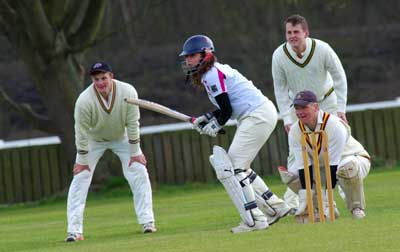Estimating scores and crowds
- Give the students the problem of estimating 193 + 156 + 43 + 281 + 120 + 314 to identify whether they use the grouping nice numbers method.
- Discuss students' methods. Use the language of estimation in the Computational estimation concept map for each different method.
-
Introduce the grouping nice numbers method in addition. This use grouping within 100, 1 000, etc., i.e., recognising two numbers which approximately sum to 100, 1 000, etc. You may wish to write this example down as you discuss it.
Example: 193 + 156 + 43 + 281 + 120 + 314
193 and 314 group to about 500,
156 and 43 group to about 200,
281 and 120 group to about 400, so the answer is about 500 + 200 + 400 = 1 100. - Students complete the sentence with the word "grouping nice numbers", and then answer parts b) and c) to assess if they can apply it. Emphasise they are to use grouping nice numbers only.


|
a) |
Makes a reasonable estimate close to 1 100 and gives a reasonable explanation of their method of estimating it. An example of using grouping nice numbers is: 1 100 because |
1 mark |
|
|
b) |
A reasonable estimate close to 3 300 and student working that indicates they can group nice numbers together. An example is 3 300 because |
1 mark |
|
|
c) |
|
Students ...
|
|
| Common error | Likely misconception | |
|
a) b) |
1 107 3 312 |
Performs the exact calculation. |
|
a) b) |
1 100 3 310 (or 3 300) |
Performs the exact calculation and then rounds to the nearest 10, 100, etc. |
| c) |
Numbers pairs such as 162 + 238 = 400 or 2 372 + 4 628 = 7 000 |
Constructs numbers which exactly group to 100, 1 000, etc., rather than ones that roughly group to 100, 1 000, etc. Not using estimation to get roughly 400, 7 000, etc. |
Information on grouping nice numbers for estimation.
- Grouping nice numbers exploits groupings within 100, 1 000, etc., but emphasises approximate groupings rather than exact ones, e.g., 156 + 43 160 + 40 or 223 + 173 230 + 170.
Prior knowledge required
- A firm base of additive basic facts, especially 7 + 3 = 10, 16 + 14 = 30, etc., (groupings within 10).
- Good place value concepts.
- Understanding that estimation is a quick mental way of getting an answer close to the exact one.
- Knows some computational estimation methods, especially rounding or front-end.
For more information about computational estimation see the Computational estimation concept map.
Grouping nice numbers involves at least early additive part-whole (Stage 5) knowledge and strategies. The method uses the groupings within 100, 1000 strategy (see The Number Framework, Book 1 (2004, pp.12-13. Wellington: Ministry of Education).

